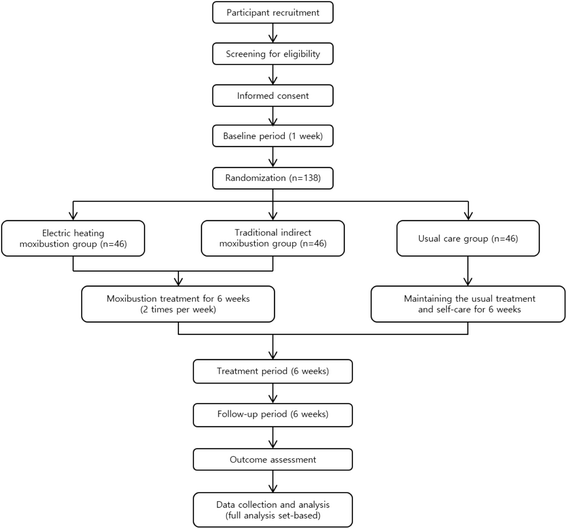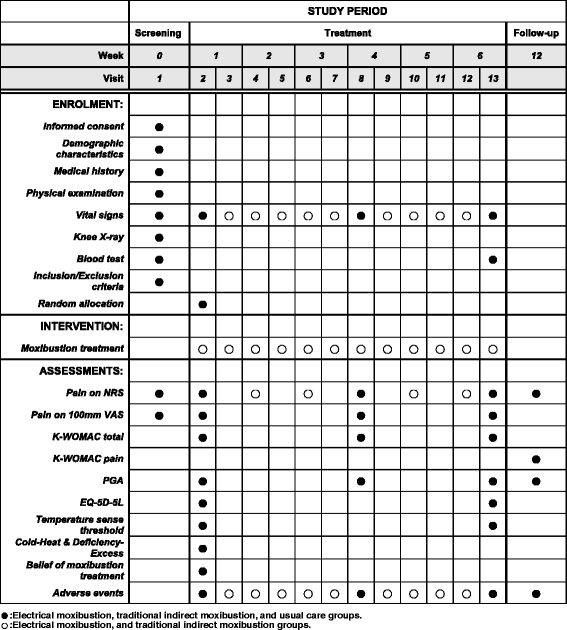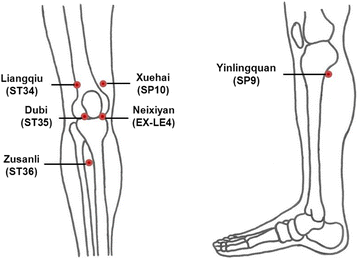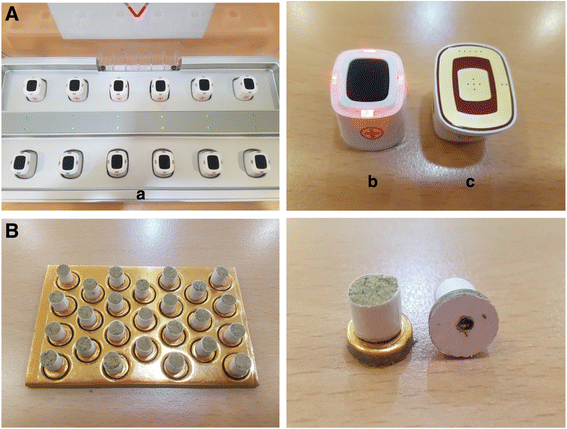Efficacy and safety of electrical moxibustion for knee osteoarthritis: study protocol for a randomized controlled trial
- PMID: 29506572
- PMCID: PMC5836464
- DOI: 10.1186/s13063-018-2514-x
Efficacy and safety of electrical moxibustion for knee osteoarthritis: study protocol for a randomized controlled trial
Abstract
Background: Knee osteoarthritis (KOA) is a significant health issue because it causes pain and functional limitation. Many studies have reported that moxibustion, a treatment in traditional Korean medicine, is effective in treating KOA. However, conventional moxibustion produces smoke, harmful gases, and odors that can adversely affect the eyes, skin, and throat. It is also difficult to control the intensity of stimulation in conventional moxibustion. An electrical moxibustion device was developed to circumvent these problems, but there are few studies of that device. We will evaluate the efficacy and safety of electrical moxibustion as a treatment for KOA, and compare it with traditional indirect moxibustion and usual care.
Methods: This is a multicenter, randomized, open, assessor-blinded, parallel-group clinical trial. A total of 138 eligible participants with KOA will be randomly allocated into three groups (electrical moxibustion, traditional indirect moxibustion, or usual care) with a 1:1:1 ratio. Participants in each moxibustion group will receive 12 sessions of moxibustion treatment at 6 acupoints (ST36, ST35, ST34, SP9, EX-LE4, SP10) plus up to 2 points of "ashi", if needed, over a period of 6 weeks (2 sessions per week). A specifically designed device that provides thermal stimulation using electrical energy will be used for the electrical moxibustion group. Participants in the usual care group will receive usual treatment and self-care. The primary outcome measure is change in pain on a numerical rating scale (NRS) from week 1 to week 6. The secondary outcome measures are pain assessed on a visual analog scale (VAS), the Korean version of the Western Ontario and McMaster osteoarthritis index (K-WOMAC), patient global assessment (PGA), and the European quality of life five dimension five level scale (EQ-5D-5 L). Safety will be assessed by monitoring adverse events at each visit. Follow-up measurements will be performed at 12 weeks after baseline measurements.
Discussion: This trial will provide evidence on the efficacy and safety of electrical moxibustion as a treatment for KOA.
Trial registration: ClinicalTrials.gov, NCT03287570 . Registered on 19 September 2017.
Keywords: Electrical moxibustion; Knee osteoarthritis; Moxibustion; Randomized controlled trial.
Conflict of interest statement
Ethics approval and consent to participate
The protocol was written according to general ethical guidelines of the Declaration of Helsinki and Korean Good Clinical Practice. The protocol was also approved by the Institutional Review Board of each trial center (protocol number 2017–0002, protocol version 3.1) and was registered at ClinicalTrials.gov. All participants will be informed of the methods of the trial, including potential benefits, possible adverse events, and personal responsibilities, and will then provide written informed consent.
Consent for publication
All authors have reviewed the final manuscript, and consent for publication. There are no personal or private data contained in this manuscript.
Competing interests
The authors declare that they have no competing interests.
Publisher’s Note
Springer Nature remains neutral with regard to jurisdictional claims in published maps and institutional affiliations.
Figures




Similar articles
-
Effectiveness and safety of electrical moxibustion for knee osteoarthritis: A multicenter, randomized, assessor-blinded, parallel-group clinical trial.Complement Ther Med. 2020 Sep;53:102523. doi: 10.1016/j.ctim.2020.102523. Epub 2020 Jul 26. Complement Ther Med. 2020. PMID: 33066857 Clinical Trial.
-
Comparison of the efficacy between conventional moxibustion and smoke-free moxibustion on knee osteoarthritis: study protocol of a randomized controlled trial.Trials. 2017 Apr 24;18(1):188. doi: 10.1186/s13063-017-1846-2. Trials. 2017. PMID: 28438185 Free PMC article. Clinical Trial.
-
Moxibustion using different habitat moxa floss for moderate to severe primary knee osteoarthritis: study protocol for a three-armed randomized, double-blinded, sham-controlled trial.Trials. 2018 Jul 27;19(1):403. doi: 10.1186/s13063-018-2794-1. Trials. 2018. PMID: 30053899 Free PMC article.
-
The Effectiveness and Safety of Moxibustion for Treating Knee Osteoarthritis: A PRISMA Compliant Systematic Review and Meta-Analysis of Randomized Controlled Trials.Pain Res Manag. 2019 Dec 17;2019:2653792. doi: 10.1155/2019/2653792. eCollection 2019. Pain Res Manag. 2019. PMID: 31949547 Free PMC article.
-
Extracorporeal shockwave therapy improves pain and function in subjects with knee osteoarthritis: A systematic review and meta-analysis of randomized clinical trials.Int J Surg. 2020 Oct;82:64-75. doi: 10.1016/j.ijsu.2020.07.055. Epub 2020 Aug 13. Int J Surg. 2020. PMID: 32798759
Cited by
-
Ultrasonic device developed for non-invasive moxibustion therapy.Integr Med Res. 2021 Dec;10(4):100729. doi: 10.1016/j.imr.2021.100729. Epub 2021 May 19. Integr Med Res. 2021. PMID: 34150497 Free PMC article.
-
Efficacy and safety comparison of infrared laser moxibustion and traditional moxibustion in knee osteoarthritis: study protocol for a Zelen-design randomized controlled non-inferiority clinical trial.J Orthop Surg Res. 2023 Dec 2;18(1):922. doi: 10.1186/s13018-023-04408-x. J Orthop Surg Res. 2023. PMID: 38042770 Free PMC article.
-
Efficacy of Acupuncture-Related Therapy in the Treatment of Knee Osteoarthritis: A Network Meta-Analysis of Randomized Controlled Trials.J Pain Res. 2021 Jul 19;14:2209-2228. doi: 10.2147/JPR.S315956. eCollection 2021. J Pain Res. 2021. PMID: 34321920 Free PMC article. Review.
-
Moxibustion for treating knee osteoarthritis: A protocol for systematic review and meta analysis.Medicine (Baltimore). 2020 May;99(19):e19974. doi: 10.1097/MD.0000000000019974. Medicine (Baltimore). 2020. PMID: 32384448 Free PMC article.
-
Effects of ozone combined with articular injection of sodium hyaluronate on patients with knee osteoarthritis and their inflammatory factors and hemorheological indices.Afr Health Sci. 2023 Jun;23(2):360-366. doi: 10.4314/ahs.v23i2.40. Afr Health Sci. 2023. PMID: 38223641 Free PMC article. Clinical Trial.
References
-
- Yanhong C, Xiaobing S. Current status and progress on the epidemiology of knee osteoarthritis at home and abroad. Chin J Tradit Med Traumatol Orthop. 2012;20(6):81–84.
Publication types
MeSH terms
Associated data
Grants and funding
LinkOut - more resources
Full Text Sources
Other Literature Sources
Medical

